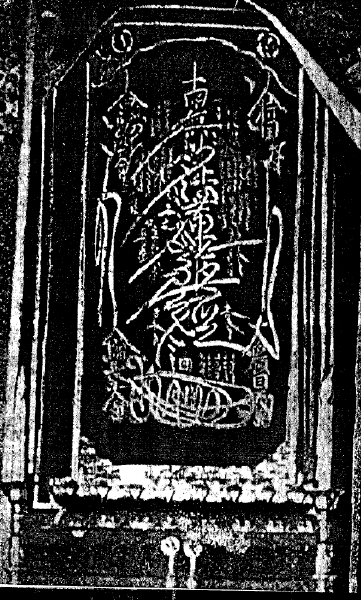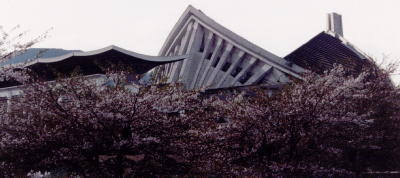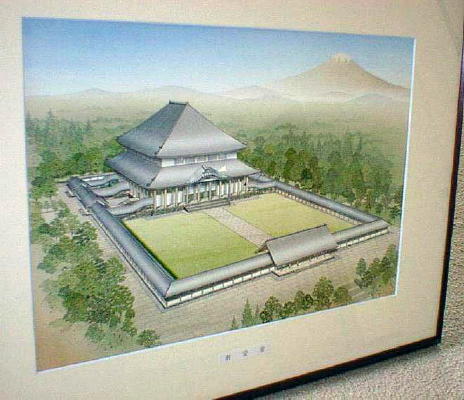Issues Regarding Nichiren Shoshu Claims
II. The Dai-Gohonzon, a.k.a. Ita-Mandala:
The Nichiren Shoshu claim that on October 12, 1279 Nichiren Shonin inscribed
the Dai-Gohonzon. This Dai-Gohonzon (above) is allegedly the supreme object of
worship for all people. However, no one outside the priesthood of
Nichiren Shoshu (including the priests and scholars of other Fuji school
lineages of Nikko) gives any credence to this story.
The legend is that the Dai-Gohonzon was inscribed by Nichiren after
the Atsuhara persectution in which laymembers gave their lives to uphold
the Odaimoku. The Dai-Gohonzon was dedicated to someone named Yashiro Kunishige.
The Dai-Gohonzon was then carved from a log of camphor wood found in a
stream at Mt. Minobu by a disciple of Nichiren named Nippo. Supposedly,
Nichiren referred to the creation of the Dai-Gohonzon in the "Shonin
Gonan Ji" gosho where he says:
"The Buddha fulfilled the purpose of his advent in a
little over forty years; T'ien-t'ai took about thirty years, and Dengyo,
some twenty years. I have repeatedly spoken of the indescribable persecutions
they suffered during those years. For me it took twenty-seven years, and
the persectuions I faced during this period are well known to you all."
There is nothing in this gosho, however, to make it clear what Nichiren
was actually referring to. There is certainly no direct reference to any
kind of Omandala let alone a Dai-Gohonzon. A gosho called the "Jogyo
Shoden Sho" refers to Nippo carving a statue of Nichiren from a log
found in a river but this gosho is believed to be a pious forgery.
The legend of the Dai-Gohonzon goes on to say that Nikko took
the wooden carving of the Dai-Gohonzon with him when he left Mt. Minobu.
More specifically the legend states that a priest named Hakken-bo, one
of Nikko's disciples, carried it on his back and that it was later deposited
at Taisekiji.
The problem is that none of the extant writings of Nikko refer to the
Ita-mandala or any kind of specific Dai-Gohonzon carved for all mankind.
In fact, Nikko's writings indicate that he didn't even approve of wooden
mandals like the Dai-Gohonzon. In the aforementioned "Fuji Isseki Monto
Zonchi-no-koto", Nikko states his disapproval of honzons should not
be enscribed on planks of wood because it would devalue the hand written
Omandalas. He was worried that if sturdier wooden copies were made then
the paper Omandala originals would be neglected. On the other hand, in
the "Hara dono gohenji" Nikko also states that the use of mandalas
was only a temporary expedient until such time as carvings of the Original
Buddha flanked by the four Original Disciples, the Four Leaders of the
Bodhisattvas of the Earth, could be established. Would Nikko have written
such things if he had been in possession of the Dai-Gohonzon?
Furthermore, Nikko did leave four authentic Nichiren Omandalas at Kitayama
Honmonji where he spent the rest of his life. Those Omandalas were eventually
given to other Nikko lineage temples: Myokakuji in Kyoto, Honnoji in Kyoto,
Honmonji in Kyoto, and Hokkeji in Kagawa Prefecture. On these, Nikko wrote:
"Hanging it up in Honmonji, one should make it the esteemed jewel of the
Latter Age." The reference to Honmonji is most obviously to Kitayama Honmonji
and not to Taisekiji. It is also odd that Taisekiji, the other temple founded
by Nikko and claimed to be the location of his main lineage by the Nichiren
Shoshu, did not receive any of these authentic Nichiren Omandalas. That
by itself proves nothing, but it is a curious comment on Nikko's attitutde
towards Taisekiji. Some have suggested that he left Taisekiji and founded
Kitayama Honmonji because he did not want to entrust the future of his
(really Nichiren's) teachings to the family of Nanjo Tokimitsu who controlled
it as their family temple. In any case, Nikko's grave is at Kitayama Honmonji
and it is oriented not towards Taisekiji and the alleged Dai-Gohonzon,
but towards Nichiren's grave at Mt. Minobu.
The first mention of the Dai-Gohonzon is during the tenure of Nichiu,
the ninth high priest of Taisekiji. He allegedly revealed it's existence
in 1488. Nichiu claimed that it had been given to Taisekiji by Yashiro Kunishige,
who the Dai-Gohonzon is edicated to, but Nichijo a contemporary of Nichiu
and the head priest of Kitayama Honmonji actually accused Nichiu of forging
the Dai-Gohonzon himself. Again, no one has been able to determine who
Yashiro Kunishige was. He could not have been one of the Atsuhara peasants
who were being persecuted since peasants did not have family names. And
why would Nichiren inscribe a Dai-Gohonzon for all mankind to anyone but
one of his major disciples or perhaps the ruler of the country? In any
case, the story of Yashiro Kunishige bestowing the Dai-Gohonzon contradicts
the story that it was kept at Mt. Minobu until Hakken-bo carried it there
on his back when Nikko left for the environs of Mt. Fuji.
So where did the Ita-mandala come from if it is not the Dai-Gohonzon
inscribed for all mankind by Nichiren Shonin and left to Nikko who brought
it to Taisekiji? In the Muromachi period after 1333, board mandalas like
the Ita-mandala were used by the Hokke Koshu (Dharma Flower Assemblies)
which followed Nichiren's teachings. In fact, "Hokke (Ko)shu" is written
on the Ita-mandala after the name Yashiro Kunishige. It is therefore most
likely that the Ita-mandala was carved sometime after 1333 at the earliest.
The question must then be asked, is the Ita-mandala a copy of a Nichiren
Omandala at all? In 1910 a photograph was taken of the Ita-mandala with
the permission of Taisekiji (see above). This photo was then analyzed by Suzuki Ichiro
and Yamanaka Kihachi who had exhaustively studied and analyzed Nichiren's
handwriting on all his extant gosho and Omandalas. In their estimation,
the Ita-mandala is from the year 1280 and not 1279. They especially refer
to the size of the Odaimoku which got larger in the years 1280-1282. They
pointed out that the Ita-mandala is virtually identical to an authenticated
Nichiren Omandala found at Myokaiji Temple in Numatsu near Mt. Fuji.
Since the Nichiren Shoshu are not merely claiming that the Ita-mandala
is a carved copy of a Nichiren Omandala, but rather that it is the Dai-Gohonzon
which all people must worship in order to attain enlightenment the burden
of proof is on them. However, Nichiren never makes any reference to having
carved or to having commissioned the carving of any such item. While Nichiren
does speak of Omandalas and statue arrangements to depict the Gohonzon,
it is clear from his writings that he, like other Buddhists, regarded the
Gohonzon as the primary reality of the Buddha and/or the Dharma and that
such plastic representations were secondary.
Neither Nikko, nor the other five major disciples, nor any of their
immediate successors ever mention the existence of a Dai-Gohonzon that
was supreme to all the other Omandalas that Nichiren had inscribed and
bestowed. This is especially curious, because if Nikko had taken such a
treasured item from Mt. Minobu, one would think this would raise some complaint
or at least comment. If the Ita-mandala was actually the all important
Dai-Gohonzon, it is curious that no mention is made of it until 1488. Furthermore,
the earliest text to discuss it at any length is the "Kechu Sho"
in 1662, and it is believed that even the references to it in that writing
have been tampered with.
It would seem, therefore, that the Ita-mandala is a "Gohonzon"
which was carved in imitation of an authentic Nichiren Omandala from 1280,
but there seems to be no concrete evidence that it is The Gohonzon which
the Nichiren Shoshu claims it is. In fact, there is evidence to indicate
that it was most likely created after the time of both Nichiren and Nikko.
My thanks to Senchu Murano, Jackie Stone, Bruce Maltz, and Chris Holte
for providing all this information.
Namu Myoho Renge Kyo,
Ryuei
|





